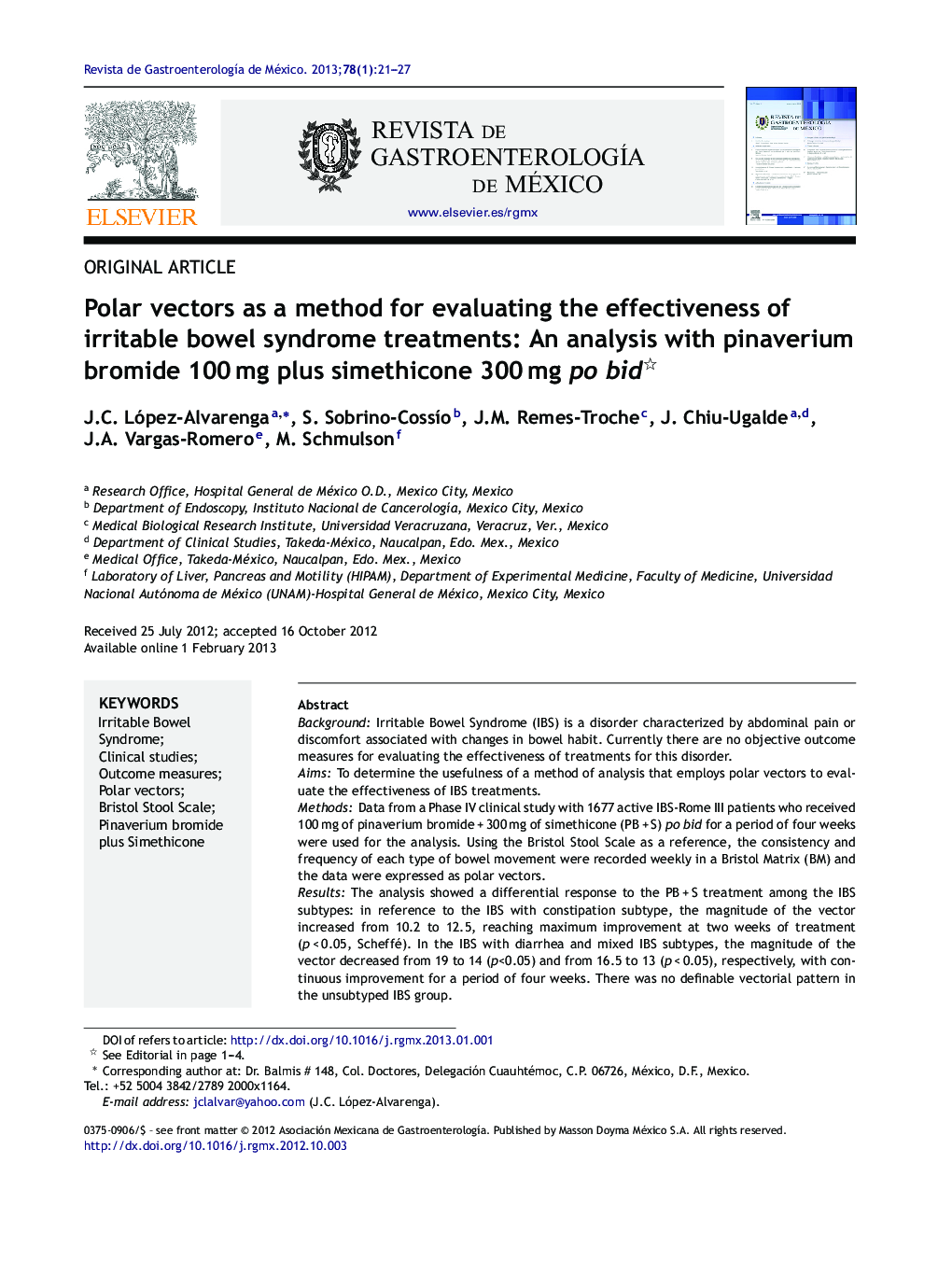| کد مقاله | کد نشریه | سال انتشار | مقاله انگلیسی | نسخه تمام متن |
|---|---|---|---|---|
| 3318895 | 1211650 | 2013 | 7 صفحه PDF | دانلود رایگان |

BackgroundIrritable Bowel Syndrome (IBS) is a disorder characterized by abdominal pain or discomfort associated with changes in bowel habit. Currently there are no objective outcome measures for evaluating the effectiveness of treatments for this disorder.AimsTo determine the usefulness of a method of analysis that employs polar vectors to evaluate the effectiveness of IBS treatments.MethodsData from a Phase IV clinical study with 1677 active IBS-Rome III patients who received 100 mg of pinaverium bromide + 300 mg of simethicone (PB + S) po bid for a period of four weeks were used for the analysis. Using the Bristol Stool Scale as a reference, the consistency and frequency of each type of bowel movement were recorded weekly in a Bristol Matrix (BM) and the data were expressed as polar vectors.ResultsThe analysis showed a differential response to the PB + S treatment among the IBS subtypes: in reference to the IBS with constipation subtype, the magnitude of the vector increased from 10.2 to 12.5, reaching maximum improvement at two weeks of treatment (p < 0.05, Scheffé). In the IBS with diarrhea and mixed IBS subtypes, the magnitude of the vector decreased from 19 to 14 (p<0.05) and from 16.5 to 13 (p < 0.05), respectively, with continuous improvement for a period of four weeks. There was no definable vectorial pattern in the unsubtyped IBS group.ConclusionsAnalysis with polar vectors enables treatment response to be measured in different IBS subtypes. All the groups showed improvement with PB + S, but each one had its own characteristic response in relation to vector magnitude and direction. The proposed method can be implemented in clinical studies to evaluate the efficacy of IBS treatments.
ResumenAntecedentesEl Síndrome de Intestino Irritable (SII) es un trastorno caracterizado por dolor o malestar abdominal, asociado a cambios en el hábito intestinal. Actualmente no existe una variable objetiva para evaluar la eficacia de los tratamientos para este trastorno.ObjetivoDeterminar la utilidad de un método de análisis con vectores polares para evaluar la eficacia de los tratamientos para el SII.MétodosPara el análisis, se utilizaron los datos de un estudio clínico fase iv con 1,677 pacientes SII-Roma III, que recibieron bromuro de pinaverio 100 mg + simeticona 300 mg (BP + S) po bid por 4 semanas. Se registraron semanalmente la consistencia y la frecuencia de cada tipo de evacuación en una Matriz de Bristol (MB) y los datos se representaron como vectores polares.ResultadosEl análisis mostró una respuesta diferencial de los subtipos de SII al BP + S: en SII-estreñimiento, la magnitud vectorial se incrementó de 10.2 a 12.5, alcanzando una mejoría máxima a las 2 semanas de tratamiento (p < 0.05 prueba de Schefé). En SII-diarrea y SII-mixto, la magnitud del vector disminuyó de 19 a 14 (p < 0.05) y de 16.5 a 13 (p < 0.05), respectivamente, con mejoría continua durante las 4 semanas. En SII-no clasificable no existió un patrón vectorial definido.ConclusionesEl análisis con vectores polares permite medir la respuesta a tratamiento en los diferentes subtipos del SII. Todos los subtipos mostraron mejoría con BP + S, pero cada uno respondió en forma característica en magnitud y dirección del vector. El método propuesto puede ser implementado en estudios clínicos para evaluar la eficacia de los tratamientos para el SII.
Journal: Revista de Gastroenterología de México - Volume 78, Issue 1, January–March 2013, Pages 21–27